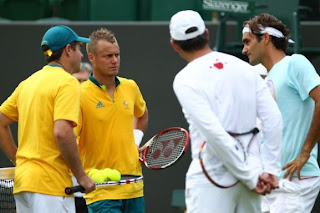One other advantage of the big-three is that people in the tennis world started to really care about Olympics, which makes it at least as important as a Grand Slam or even more, favoring the players who can play under pressure. (although still being in test run, we can assume that Murray can handle pressure at least in Wimbledon).
That's why, I don't see the draw as indicative. (here is the draw) For, sure Djokovic is on the hardest part of the draw. If you look in detail, all the best players attended the Olympics and each constitutes a threat. For example, Nalbandian is always a serious threat who leads Federer in head-2-head stats. Players with big serves, Raonic, Isner, Tsonga, Berdych, Del Potro are always serious threats. Remember what Tsonga did to Federer in Wimbledon 2011. He gave him his first defeat from two sets to love. Roddick overpowered Federer in Miami this year. Nalbandian was about to defeat Nadal in Indian Wells. Raonic had a close match with Federer in Halle, which was a battle of serves.
What I'm trying to say is, there are many good players in the draw. Some are playing really good tennis right now like David Ferrer, who saw his first SF in Wimbledon this year, Cilic, who won a tournament before coming here and saw a final, Tipsaravic as well had a championship and a final after playing in Wimbledon. Some are not as good but still can blast and play a few good matches like Roddick or Isner. However, Olympics is quite a journey, in which you must venture through 6 difficult matches and also wear the flag of your nation.
 |
| Players play in Olympics for themselves and for their nation as well, which slightly separates the Olympics from other tournaments. |
Aside from the challengers to the reign of top-4, I'd like to stress a bit on the top-4. As you know Nadal suffering from his tendinits is out so we're left with Federer, Djoker and Andy. I think Djokovic still has the most potential to win but also less likely to win, because he may face strong opponents a possible quater-final with Raonic or Tsonga is waiting for him before he opposes Murray or Federer. But he is consistent, his play does not heavily depend on serve, since he is the best returner of the game and has an outstanding baseline play, which he adapted to grass as well. So, the biggest issue for him would be how will he react and use his serve against big servers on grass.
Murray is in very good form, as he played a very good match against Federer in the Wimbledon final. He was really consistent and did just several unforced errors in the first two sets and pushed Federer really to the edge before Federer sorted things out with the help of closed roof. He will definitely try again. Having on of the best returns in the game and good reflexes, he is prepared to face big servers as well. We will have a chance to see the added value of Ivan Lendl on his corner, who has a hard job recovering his protege after his last loss.
Finally, I don't see Federer as an invincible player right now, even on grass. I believe he would quit Wimbledon in 3rd round, unless Bennetau maintained his form and health throughout the match. The same argument is valid for his win against Del Potro on RG, since he was barely moving on the court in the last sets. What would be the odds for Federer, if he had lost both to Del Potro and Bennetau and was the number 4 right now? I acknowledge his fighting spirit and finding a remedy to each opponent, but the conditions and odds really favored him in the last 2 months. Furthermore, as I mentioned in my previous posts 'Big Champs Strike Back' the closing of the definitely aided him in his final and semi-final clashes. It is also very obvious for me that he can't stay in rallies with the strong and consistent guys like Djokovic, Murray and arguably against Ferrer or Del Potro at least on clay. I believe his genius will help him to sort things out at least to some extent, but he definitely needs consistent and to the point first serves.
To conclude, the big-three will be the major contenders counting days to win their first Olympic Medals and all knowing they might not have another chance. And for the contenders, players who have a great serve may be a contender for a medal, like Raonic, Tsonga, Roddick or Berdych but not Ferrer or Tipsaravic. I think they have a chance to make an impact in best of 3-sets and get at least a medal maybe not a gold one.




